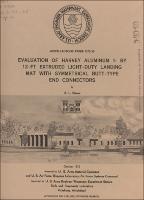Please use this identifier to cite or link to this item:
https://hdl.handle.net/11681/20982Full metadata record
| DC Field | Value | Language |
|---|---|---|
| dc.contributor | United States. Army Materiel Command | - |
| dc.contributor | Air Force Weapons Laboratory | - |
| dc.contributor.author | Green, Hugh L. | - |
| dc.date.accessioned | 2017-01-17T21:36:10Z | - |
| dc.date.available | 2017-01-17T21:36:10Z | - |
| dc.date.issued | 1972-10 | - |
| dc.identifier.govdoc | Miscellaneous Paper S-72-38 | - |
| dc.identifier.uri | http://hdl.handle.net/11681/20982 | - |
| dc.description | Miscellaneous Paper | - |
| dc.description | Abstract: The investigation reported herein was conducted to evaluate an extruded aluminum alloy landing mat that was designed and fabricated by Harvey Aluminum Company, Inc., Torrance, Calif. The 1- by 12-ft mat is a one-piece hollow extrusion fabricated from 6063 aluminum alloy artificially aged to the T6 condition and weighs 2.81 lb per square foot of placing area. The mat panels are interlocked along the sides b y means of a hinge-type connector, the components of which are integral parts of the basic extrusion. End connectors, which are composed of 6061-T6 extruded aluminum connectors with integral inserts welded to the basic panel using the electron beam welding method, consist of symmetrical butt-type sections that are secured by a locking bar after individual panels have been joined together. The investigation consisted of laboratory, traffic, and skid tests to obtain information for use in evaluating Harvey mat for potential use as a light-duty landing mat. The test data reported herein were evaluated against the criteria for light-duty mat as established in the revised Qualitative Materiel Requirement presented as Appendix A. Traffic tests were conducted with the mat placed on a prepared subgrade and trafficked with a rolling wheel load simulating actual aircraft operations. The tests were conducted using the C-130 aircraft loading, which consists of a single-wheel load of 30,000 lb with a tire inflation pressure of 100 psi, on a subgrade with an average CBR of 3.2. Results of this investigation revealed that the Harvey light-duty mat sustained 160 actual coverages of traffic on a subgrade with a rated CBR of 3.1, which is equivalent to 430 coverages on a 4-CBR subgrade, This falls short of the coverage criterion for light-duty mat, i. e., 1000 coverages on a 4-CBR subgrade. Failure of the panels occurred in the mat body, with breakage in the top skins, bottom skins, and internal vertical members. No failures occurred at the end joints in the vicinity of the welds even though voids were present in the welds in some areas. The placement rate of the mat was 350 sq ft per man-hour. The average coefficients of friction obtained from skid tests on wet and dry surfaces were 0.57 and 0.58, respectively. The tire wear resulting from skidding on both the wet and dry surfaces was not considered signficant. Laboratory tests conducted on the mat indicated that the 6063-T6 alloy generally exceeded the minimum physical requirements. | - |
| dc.publisher | Soils and Pavements Laboratory (U.S.) | - |
| dc.publisher | Engineer Research and Development Center (U.S.) | - |
| dc.relation | http://acwc.sdp.sirsi.net/client/en_US/search/asset/1047866 | - |
| dc.relation.ispartofseries | Miscellaneous Paper (U.S. Army Engineer Waterways Experiment Station) ; S-72-38 | - |
| dc.rights | Approved for public release; distribution is unlimited. | - |
| dc.source | This Digital Resource was created from scans of the Print Resource | - |
| dc.subject | Aluminum landing mats | - |
| dc.subject | Harvey landing mats | - |
| dc.subject | Landing mats | - |
| dc.subject | Traffic tests | - |
| dc.subject | Trafficability | - |
| dc.title | Evaluation of Harvey Aluminum 1- by 12-ft extruded light-duty landing mat with symmetrical butt-type end connectors | - |
| dc.type | Report | en_US |
| Appears in Collections: | Miscellaneous Paper | |
Files in This Item:
| File | Description | Size | Format | |
|---|---|---|---|---|
| MP-S-72-38.pdf | 17.45 MB | Adobe PDF |  View/Open |